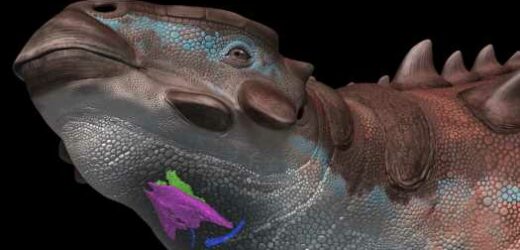In the next generation of dinosaur-based blockbuster films, some of the star creatures could perhaps sound more like a bird and a little less like a roaring lion.
At least that’s a possibility raised from new research published this month, although very little is really understood about dinosaur vocals.
But a research team has drawn clues about sounds the extinct creatures could have made from what might be the first known fossilized larynx of a dinosaur. It comes from an ankylosaur, a group of armored, plant-eaters that were not close relatives of birds. This squat, spiky dinosaur (Pinacosaurus grangeri) was unearthed in 2005 in Mongolia.
Junki Yoshida, a paleontologist at the Fukushima Museum in Japan, said the find was surprising because the body parts involved in vocalization, including the larynx, which is often made of cartilage but can be bony in some animals, were not considered to be good candidates for preservation as fossils. (The larynx in some animals is located near the upper part of the windpipe and contains the vocal cords.)
To try to glean what sounds a dinosaur might have uttered, Dr. Yoshida’s team also looked to the evolutionary relatives of those Cretaceous creatures, including birds and the dinosaurs’ closest cousins — crocodiles.
More on Birds
“They kind of bracket the range of sounds we might expect,” said Victoria Arbour, a paleontologist at the Royal BC Museum in Victoria, Canada, who was not involved in the new study.
Crocodiles’ vocal repertoire includes deep rumbles and hisses. “Assuming that dinosaurs make some crocodile-like sounds is pretty safe,” she said. “That’s the base anatomy they’d be working with. And then birds evolved these additional ways of producing sounds where they can modify the sounds coming out of their throat in a more nuanced way.”
Birds and reptiles have very different ways of producing sounds using the organs that surround their windpipes and lungs. In extinct and living crocodile relatives, the larynx produces sound. Birds possess a different organ, called the syrinx, that sits close to their lungs to produce sound. They also have another organ, located near their mouths, for changing up those sounds, allowing some birds to create elaborate songs.
Dr. Yoshida and his colleagues sized up two parts of the larynx, which would have supported muscles involved in opening the airway and changing its shape. In the anklyosaur, the parts were both bones. The team compared their proportions to the larynxes from dozens of birds and reptiles, including crocodiles, geckos and turtles.
One part that forms the base of the anklyosaur’s larynx was very large compared to those of other animals, suggesting that this dinosaur could open its airway wide to make loud calls that could be heard far away, Dr. Yoshida said. The other larynx part, a relatively long pair of bones, could have permitted the windpipe to change shape to modify sounds, he added. That might have allowed ankylosaurs to vocalize in a way similar to birds, the researchers reported recently in the journal Communications Biology.
People might assume that sounding birdlike would mean these dinosaurs were tweeting like meadowlarks, Dr. Arbour said. That’s probably not true, but “they might have had a broader range of sounds then we might give ankylosaurs credit for otherwise,” she said.
“There’s still possibilities that they made chirping and cooing” noises, Dr. Yoshida said. But it is too soon to understand what specific sounds dinosaurs might have made, he cautioned. Even a single bird species makes a wide range of noises, and there are other organs at play, from the mouth and nose to possibly a syrinx, he said.
Julia Clarke, a paleontologist at the University of Texas at Austin who was not part of the study, found the analysis intriguing. But she said that the way these larynx parts and other nearby bones were arranged in the anklyosaur did not resemble those in birds.
“Only in pterosaurs do we see something like the birdlike condition,” she said.
It’s not clear how the structures that the team analyzed would allow an ankylosaur to vary sounds, Dr. Clarke said. Birds don’t use the larynx for this purpose. They have an organ she called a hyolaryngeal basket that moves up or down to modify their calls. And the larynx shows up in all tetrapods — a group that includes animals like birds, reptiles and mammals that descended from four-limbed creatures. The anatomy described in the research varies across animals whether they can vocalize or not. “We don’t know what any of this variation means,” she said.
The larynx parts under study might have had more to do with keeping food out of the airway because they helped to open and close it, she said. And the layout of related structures in this anklyosaur also looked completely different than those of many other dinosaurs, ones that Dr. Clarke has studied and that show up in the literature.
Could other dinosaurs have sounded like birds? Maybe. Dr. Clarke and her colleagues found a fossilized syrinx from around 67 million years ago in an ancient bird. Since that was before dinosaurs went extinct, that raises the possibility that some dinosaurs may have had them. But so far, no one has found a fossilized syrinx in a non-avian dinosaur.
These larynx parts in the new study probably had to do with the unique attributes of this anklyosaur rather than something that could be generalized across dinosaurs, she said. “There are still a lot of questions about the evolution of dinosaur vocalization.”
“Ankylosaurs are weird,” Dr. Clarke said. “That is the main message.”
Source: Read Full Article


